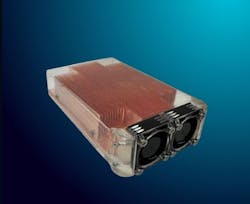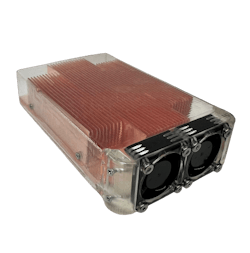Intel, Submer Advance Data Center Single-Phase Immersion Cooling for Chips Above 1000W TDP
Intel Corporation and Submer have now unveiled a system designed to cool chips with thermal design power (TDP) above 1000W. The partners said their ongoing technology collaboration, aimed at establishing a new foundation for single-phase immersion cooling technology for data centers, has reached a groundbreaking achievment in the form of the Forced Convection Heat Sink (FCHS) package.
Heralded as a milestone achievement for providing a simple, cost-effective way to cool chips up to the 1000W range in single-phase immersion systems, the FCHS package officially debuted at the 2023 OCP Global Summit (Oct. 17-19) in San Jose, with live demonstrations showing platform results in real-time.
The partners say the FCHS package stands to revolutionize data center cooling, as it reduces the quantity and cost of server components required for comprehensive heat capture and dissipation for Intel chips with TDP exceeding 1000W. The introduction of the FCHS marks the initial milestone on the path toward effectively cooling Intel silicon exceeding 1000W, while possibly setting single-phase immersion cooling apart as a frontrunner among competitive liquid cooling technologies, the companies added.
“Many have challenged the technological runway of single-phase immersion cooling," remarked Daniel Pope, co-founder and CEO of Submer. "The FCHS is the undeniable proof that immersion is here to compete head-on with other liquid cooling technologies, including direct liquid cooled water-based cold plates."
How the FCHS Package Works
Intel first announced its collaboration with immersion cooling specialist Submer in 2021 to work on Submer-cooled Intel Xeon processors in data centers. Intended as the first marker on the road toward a 1kW+ chip, the immersion cooling 800W+ Xeon processor with FCHS technology delivers numerous benefits for data centers and stands to enable CPU cooling "for generations to come," said the companies.
As noted by a Submer in its case study describing the FCHS package, natural convection stands as the primary mechanism governing heat transfer within an immersion tank. However, significantly increasing flow rates at the point of injection into the tank yields a marginal enhancement with little impact on CPU and GPU temperatures.
When coupled with immersion-optimized heat sinks, the company noted that natural convection has proved the ability to cool CPUs in the 400W power range. Nevertheless, as TDP levels surpass this threshold, novel methods for enhancing the flow of dielectric fluid through the heat sinks become imperative.
Especially designed for use in immersion cooling systems, the FCHS is a heat sink attachment which combines the heat transfer efficiency of forced convection with the resiliency of passive cooling. The FCHS attachment for immersion-optimized heat sinks integrates propellers for localized forced convection.
Intel and Submer said the FCHS package combines the efficiency of forced convection with passive cooling technologies, enabling the cooling of high TDP CPUs and GPUs in single-phase immersion systems. The companies contend the fail-proof design of the FCHS package also enables natural convection in the event of propeller failure.
Designed for easy retrofitting into any existing server and immersion tank setups, the FCHS package supports versatile integration to swiftly empower data centers to handle high-density compute workloads. The companies note the highly efficient FCHS is also cost-effective, with components that are inexpensive to manufacture and which offer the possibility of being 3D-printed.
In terms of competitive thermal performance, Intel and Submer maintain that the FCHS package delivers formidable thermal resistances rivaling those of direct liquid cooling (DLC) technology. As an option, the FCHS package can also return thermal management to the server via enablement BIOS PWM controls.
Intel and Submer said the technological breakthrough of the FCHS package paves the way for even higher TDPs and future collaborations that will solid single-phase immersion as a leading cooling approach.
Intel Fellow Mohan J. Kumar remarked, “An immersion heat sink utilizing forced convection is a key innovation in taking single-phase immersion cooling beyond the current barriers, allowing single-phase immersion not only to be a solution of today, but also a solution of the future.”
Intel's Inside Track On Immersion Cooling Advancements
Intel has been working with several companies on liquid cooling designs. As reported by DCF last year, the company expects to see greater adoption of liquid cooling, and has been with the Open Compute Project and cooling vendors to put forward standards to make the technology more accessible.
Immersion cooling submerges servers in a tank filled with liquid coolant, rather than using cold air. This approach offers potential economic benefits by allowing data centers to operate servers without a raised floor, computer room air conditioning (CRAC) units or chillers.
Interest in liquid cooling has been boosted by the growth of artificial intelligence, which relies upon powerful hardware that packs more computing power into each piece of equipment, boosting the power density – the amount of electricity used by servers and storage in a rack or cabinet – and the accompanying heat. These rising power densities are challenging traditional practices in data center cooling, and prompting data center operators to adapt new strategies to support high-density racks.
In January 2022, Intel announced an agreement with immersion technology specialist Green Revolution Cooling (GRC) to design and implement custom immersion cooling techniques in future data centers and edge deployments.
One of the main obstacles in the path of immersion cooling has been that, although many processors and servers have been tested in immersion environments, manufacturers have been loath warranty their products when they are immersed. Also in 2022, Intel delivered an industry-first immersion warranty rider for Intel Xeon processors, and won its first sustainability deals over competition with large global customers, including Microsoft and Alibaba.
Immersion cooling technology is integral to Intel’s net-zero commitments. The company notes that as much as 99% of heat generated by IT equipment can be captured in the form of water or other liquid coolants. Instead of requiring fans, the heat passes into the fluid, which is then circulated to dissipate the energy, much like an air conditioning system. That heat can also be harnessed and reused as needed.
“Immersion cooling is a disruptive technology,” said Jen Huffstetler, chief product sustainability officer in Intel’s Data Center and AI Group (DCAI). “This technology not only addresses some of the largest data center challenges – by reducing energy and water usage – it also helps our customers improve TCO (total cost of ownership) while improving overall compute density.”
Fossil Fuel Products for Use in Data Center Immersion Cooling?
Though it seems counterintuitive, certain fossil fuel products are now emerging for use in data center immersion cooling systems - and are even being touted as part of a net zero solutions approach.
In 2021, Shell Lubricants expanded its product offering to include a new immersion cooling fluid for use in data centers. Notably this April, Submer announced that, after rigorous testing, Shell fluids were approved for use in its immersion cooling products.
Made from natural gas via the Shell GTL (Gas to Liquid) technology, the Shell Immersion Cooling Fluid S5 X is designed for liquid cooling of data servers. Optimized for natural convection-driven immersion cooling systems, the S5 X can also be used in pumped/forced circulation systems.
Shell notes that, the better to help organizations meet their net-zero ambitions, compared with traditional air cooling, single-phase immersion cooling technology as an integrated solution can reduce energy use and carbon emissions in data centers by up to 48% through its high cooling efficiency.
Last December, GRC announced that Shell Lubricants had joined as the first member of GRC’s newly launched ElectroSafeFluid Partner Program. By collaborating with Shell, GRC said it expands its capability to provide state-of-the-art liquid immersion cooling solutions to meet growing customer use cases and applications, while leveraging key IT OEM partners throughout the data center ecosystem.
GRC’s ElectroSafe range of liquid coolants provides a broad spectrum of high-performance, earth-friendly, synthetic coolants that have undergone a thorough testing process. GRC’s ElectroSafe Fluid Partner Program provides a platform for collaboration to advance the performance of single-phase immersion cooling fluids.
The ElectroSafe program enables Shell and GRC to jointly evaluate and gather fluid test data through a proprietary protocol to optimize material compatibility, safety, and thermal performance, providing GRC’s customers around the world with an expanded range of trusted fluids for their unique data center requirements.
Shell is also a member of the National Science Foundation's Center for Energy-Smart Electronic Systems (ES2) research consortium, aiding in ES2's research at the forefront of investigating transferrable high-performance liquid cooling technologies for data center environments (ES2 projects address three sub-areas within this focus area: single and two-phase liquid cooling, (both direct and indirect), and immersion cooling).
For its part, also at the 2023 OCP Global Summit, to address the how ongoing adoption of cloud computing and AI is driving demand for data centers and processing power while requiring new solutions to manage power consumption and thermal energy output, ExxonMobil on Oct. 17 announced its launch of data center immersion fluid products geared to help optimize facility performance across all industries and geographies.
“Achieving the right balance between heat transfer, flashpoint and materials compatibility is essential for optimal data center server component performance. And that is where ExxonMobil’s data center immersion fluids come in,” said Alistair Westwood, global marketing manager, ExxonMobil Product Solutions. “The launch of our data center immersion fluid portfolio illustrates [how] ExxonMobil continues to leverage more than a century of innovation to produce a breakthrough solution that can tackle complex data center fluid needs.”
Keep pace with the fast-moving world of data centers and cloud computing by connecting with Data Center Frontier on LinkedIn, following us on X/Twitter and Facebook, and signing up for our weekly newsletters using the form below.
About the Author
Matt Vincent
A B2B technology journalist and editor with more than two decades of experience, Matt Vincent is Editor in Chief of Data Center Frontier.




